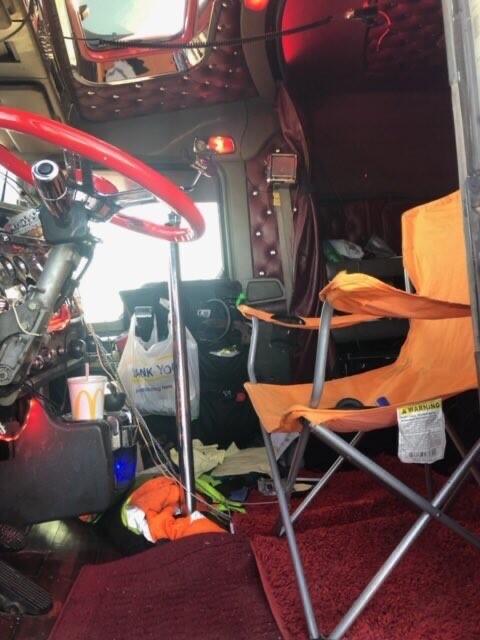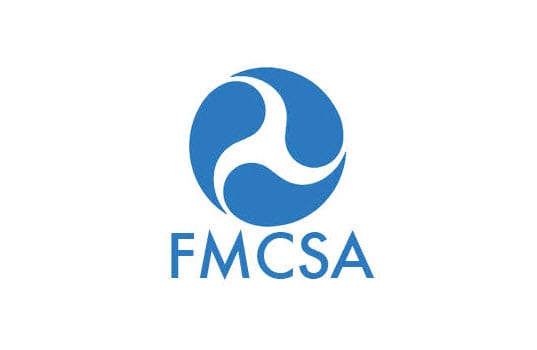This is a photo of the inside of a truck that was stopped by the Nebraska Highway Patrol in 2019!
When was the last time you looked inside the cab, body, or trailer of the trucks that your drivers are operating?
Over the years of inspecting and looking inside commercial motor vehicles for the companies I have worked for, I have seen the following items inside trucks that present unique, dangerous situations to the driver and unnecessary liability exposure to the company:
Armadillos, dogs, cats, snakes, a folding chair, television on the dash, milk crates, garbage, windows tinted beyond federal regulations, stuffed animals in the windshield, alcohol, drugs, firearms, radar detectors, and unauthorized passengers.
Some of these items are strictly prohibited by the Federal Motor Carrier Safety Regulations, and others are restricted by regulations. Regardless of the regulations, each of these items should be addressed by your company safety policy and procedures manual to ensure safe operations of your commercial motor vehicles.
Please review the following Federal Motor Carrier Safety Regulations with your drivers at it pertains to:
Items in the windshield, garbage, and clutter inside the cab
CFR 394.8(3) Interference with driver. No motor vehicle shall be driven when any object obscures his/her view ahead, or to the right or left sides, or to the rear, or interferes with the free movement of his/her arms or legs or prevents his/her free and ready access to the accessories required for emergencies or prevents the free and ready exit of any person from the cab or driver's compartment.
(4) Property on motor vehicles. No vehicle transporting persons and property shall be driven unless such property is stowed in a manner that will ensure:
- Unrestricted freedom of motion to the driver for proper operation of the vehicle;
- Unobstructed passage to all exits by any person and
- Adequate protection to passengers and others from injury due to the displacement or falling of such articles.
CFR 393.60
Prohibition on obstructions to the driver's field of view—(1) Devices mounted at the top of the windshield. Antennas, transponders, and similar devices must not be mounted more than 152 mm (6 inches) below the upper edge of the windshield. These devices must be located outside the area swept by the windshield wipers, and outside the driver's sight lines to the road and highway signs and signals.
Decals and stickers mounted on the windshield. Commercial Vehicle Safety Alliance (CVSA) inspection decals, and stickers and/or decals required under Federal or State laws may be placed at the bottom or sides of the windshield provided such decals or stickers do not extend more than 115 mm (4½ inches) from the bottom of the windshield and are located outside the area swept by the windshield wipers, and outside the driver's sight lines to the road and highway signs or signals.
FMCSA Interpretation of CFR 393.60
Question 1: May windshields and side windows be tinted?
Guidance: Yes, as long as the light transmission is not restricted to less than 70 percent of average (refer to the American Standards Association publication Z26.1-1966 and Z26.1a-1969).
Question 2: May a decal designed to comply with the periodic inspection documentation requirements of §396.17 be displayed on the windshields or side windows of a Commercial Motor Vehicle CMV?
Guidance: Yes, provided the decal is being used in place of an inspection report and complies with §393.60(c).
Question 3: If a crack extended into the thickness of the glass at such an angle as to measure 1/4" or more, measuring from the top edge of the crack on the outside surface of the windshield to vertical line drawn through the windshield to the far edge of this angled crack on the inside of the windshield, would this constitute a crack of 1/4" or more in width as defined in §393.60(b)(2)?
Guidance: No. The crack, in order to fall outside the exception, would have to be a gap of 1/4" or more on the same surface of the windshield.
Unauthorized Passengers
392.60 Unauthorized persons are not to be transported.
Unless specifically authorized in writing to do so by the motor carrier under whose authority the commercial motor vehicle is being operated, no driver shall transport any person or permit any person to be transported on any commercial motor vehicle other than a bus. When such authorization is issued, it shall state the name of the person to be transported, the points where the transportation is to begin and end, and the date upon which such authority expires. No written authorization, however, shall be necessary for the transportation of:
- Employees or other persons assigned to a commercial motor vehicle by a motor carrier;
- Any person transported when aid is being rendered in case of an accident or other emergency
Tinting of Windows
393.60 Glazing in specified openings Coloring or tinting of windshields and the windows to the immediate right and left of the driver is allowed, provided the parallel luminous transmittance through the colored or tinted glazing is not less than 70 percent of the light at normal incidence in those portions of the windshield or windows which are marked as having a parallel luminous transmittance of not less than 70 percent. The transmittance restriction does not apply to other windows on the commercial motor vehicle.
Televisions
393.88 Television receivers.
Any motor vehicle equipped with a television viewer, screen or other means of visually receiving a television broadcast shall have the viewer or screen located in the motor vehicle at a point to the rear of the back of the driver's seat if such viewer or screen is in the same compartment as the driver and the viewer or screen shall be so located as not to be visible to the driver, while he/she is driving the motor vehicle. The operating controls for the television receiver shall be so located that the driver cannot operate them without leaving the driver's seat
Alcohol
392.5 Alcohol prohibition.
Be on duty or operate a commercial motor vehicle while the driver possesses wine of not less than one-half of one per centum of alcohol by volume, beer as defined in 26 U.S.C. 5052(a), of the Internal Revenue Code of 1954, and distilled spirits as defined in section 5002(a)(8), of such Code. However, this does not apply to possession of wine, beer, or distilled spirits which are manifested and transported as part of a shipment.
Drugs and controlled substances
392.4 Drugs and other substances.
- (a) No driver shall be on duty and possess, be under the influence of, or use, any of the following drugs or other substances:
- (a)(1) Any 21 CFR 1308.11 Schedule I substance;
- (a)(2) An amphetamine or any formulation thereof (including, but not limited, to "pep pills," and "bennies");
- (a)(3) A narcotic drug or any derivative thereof; or
- (a)(4) Any other substance, to a degree which renders the driver incapable of safely operating a motor vehicle.
- (b) No motor carrier shall require or permit a driver to violate paragraph (a) of this section.
- (c) Paragraphs (a)(2), (3), and (4) do not apply to the possession or use of a substance administered to a driver by or under the instructions of a licensed medical practitioner, as defined in §382.107 of this subchapter, who has advised the driver that the substance will not affect the driver’s ability to safely operate a motor vehicle.
- (d) As used in this section, "possession" does not include possession of a substance which is manifested and transported as part of a shipment.
Animals
The Federal Motor Carrier Safety regulations do not specifically address animals inside of a commercial motor vehicle.
Firearms
Firearms by federal regulation are not specifically regulated rather each state has laws regarding transportation of firearms in motor vehicles. Most states have a concealed weapon laws which make it illegal to transport a firearm concealed in any type of motor vehicle without a permit.
Radar Detectors
392.71 Radar Detectors; use and/or possession.
- (a) No driver shall use a radar detector in a commercial motor vehicle, or operate a commercial motor vehicle that is equipped with or contains any radar detector.
- (b) No motor carrier shall require or permit a driver to violate paragraph (a) of this section.
Department of Health and Human Services (HHS) to Consider Adding Fentanyl to Drug Testing Panel
On October 17, 2023, the Substance Abuse and Mental Health Services Administration (SAMHSA), an operating division within the Department of Health and Human Services (HHS), published a notice in the Federal Register announcing that its Center for Substance Abuse Prevention (CSAP) Drug Testing Advisory Board (DTAB) will convene via web conference on December 5, 2023. Among other things, the Board will be discussing the Mandatory Guidelines for Federal Workplace Testing Programs and possible updates to the analyte table to include Fentanyl.
The Department of Transportation and its operating administrations (including the Federal Motor Carrier Safety Administration) must follow the HHS scientific guidelines for DOT-regulated drug testing laboratory procedures. Thus, participants in the DOT transportation industry drug testing program, including motor carrier employers, should be aware of this issue that HHS is considering. Any change to the HHS analyte table may affect the DOT testing program under 49 CFR Part 40, but only after DOT conducts its own rulemaking.
The advisory board will meet in an open session on December 5, 2023, from 10 a.m. to 4:30 p.m. EST. The board will discuss the Mandatory Guidelines for Federal Workplace Drug Testing Programs and updates to the analyte table to include Fentanyl. Additionally, DHHS is asking for public comments on the recommendation of adding fentanyl/nor-fentanyl to the analyte table.
Meeting registration information can be completed at https://snacregister.samhsa.gov/. Web conference and call information will be sent after completing registration.










